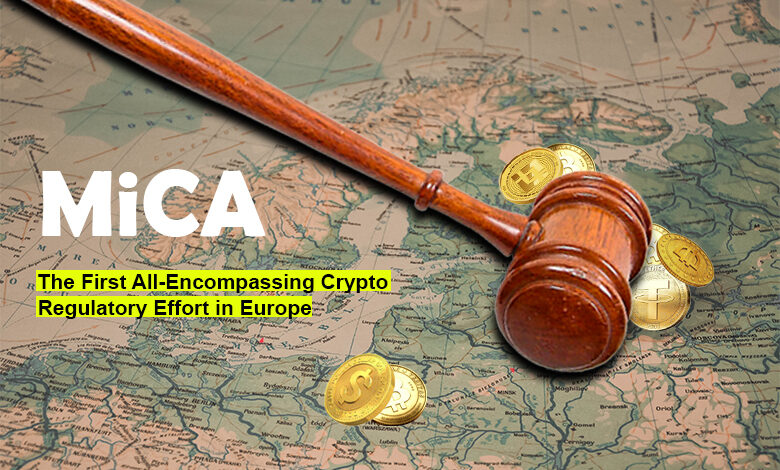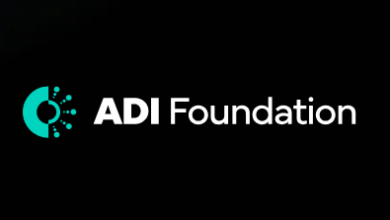MiCA: EU’s Proposed Regulatory Framework for Crypto-Assets and Its Implications for UAE

Markets in Crypto-Assets (MiCA) is the first regulatory framework proposed by the European Commission for the regulation of crypto-assets in the European Union (EU). This framework is intended to position Europe as a leader for crypto as it is the most comprehensive, thorough and clear regulatory framework for crypto assets.
While the UAE has taken the lead in creating favorable regulatory environments for virtual assets, the EU is taking a more holistic approach with MiCA.
The framework aims to establish a harmonized set of rules for the issuance, trading, and custody of digital assets, providing clarity for businesses and investors operating in the space.
Under MiCA, a crypto-asset is defined as any “digital representation of a value or a right which may be transferred and stored electronically, using distributed ledger technology or similar technology”. The regulation covers electronic money tokens (EMTs), asset-referenced tokens (ARTs), and a catch-all category for other crypto-assets, including non-pegged payment tokens (i.e., cryptocurrencies like Bitcoin or Ether) and utility tokens.
MiCA was first drafted in response to concerns regarding the potential risks to financial stability posed by Facebook’s Libra/Diem stablecoin project. Although the project has since been abandoned, recent events, such as the bankruptcy of the FTX crypto exchange and issues with other crypto services like Terra and Celsius, have highlighted the pressing need for this type of regulation.
MiCA addresses loopholes in current EU financial services legislation by creating a standardized and consistent set of regulations governing crypto-assets and associated activities and services.
Akshata Namjoshi, associate partner at KARM Legal Consultants, stated that “The granularity with which MiCA discusses crypto assets and related activities is surely a game-changer. The wide definition of crypto assets along with its nomenclature of tokens gives MICA a massive wing span. While many regulators have issued detailed regulations in the past, ratification by European Parliament makes MiCA far more dominant than others.”
“Similar to many of the regulatory frameworks we see across the Middle East, especially in the UAE and Bahrain, MiCA offers pivotal and enduring elements that will inform future regional and local regulatory frameworks” said Joanne Kubba, Binance’s Vice President of Public Affairs.
Regulatory Balance: How MiCA Protects Investors while Fostering Innovation
The main aim of MiCA is to preserve financial stability and protect investors, while promoting innovation in the crypto sector. It is part of a larger digital finance package within the EU that seeks to update the EU’s approach to various digital financial matters.
Joanne Kubba believes that “MiCA is a significant milestone for the crypto industry in the EU. It offers a clear, tailored, and consistent regulatory framework and set of rules for crypto businesses that operate in the EU, reducing regulatory uncertainty and simplifying compliance. This creates a favorable environment for innovation and growth within the sector”.
Currently, individuals are not protected by EU consumer protection rules when dealing with these assets. Moreover, they often lack adequate information about the risks involved, which could result in financial losses.
The unregulated use of crypto-assets could lead to market manipulation, financial crime, and financial instability. For this reason, MiCA requires crypto asset service providers (CASPs) to implement anti-money laundering measures and obliges management bodies to assess and periodically review policy arrangements and compliance procedures. Infringements may result in significant fines.
MiCA also aims to promote innovation in the crypto-asset market by creating a clear and predictable regulatory environment, encouraging the proper use of blockchain technology, and facilitating member states’ cooperation through the European Blockchain Partnership (EBP).
Companies that register under MiCA will enjoy a passporting license, enabling them to operate throughout the EU without obtaining separate licenses in individual member states.
According to Caroline Malcolm, head of international public policy and research at Chainalysis, “This common regime and a passporting approach to licensing will be very significant game changers”.
He added, “It will open up services across Europe and allow new entrants to scale, which wasn’t really viable before.”
Possible Implications of MiCA for Crypto Businesses and Regulators in UAE
MiCA regulates primary market activities such as issuance/public offerings and access to the secondary market (listings). It also regulates the provision of ten “crypto-asset services” based on the list of investment services in the Markets in Financial Instruments Directive 2014/65/EU (MiFID II).
These services include custody and administration of crypto-assets on behalf of third parties and operating a trading platform.
The regulations will not only affect companies that are registered in the EU, but also those that market crypto to customers within the EU due to the borderless nature of the industry. However, non-European providers of crypto services, like those operating in the UAE, may be required to obtain MiCA authorization if they offer cross-border services to the EU, including issuers, custodians, exchanges, and other intermediaries.
MiCA particularly puts a toll on crypto custodians as the liability of crypto custodians is extensive in the regulation. While this benefits investor protection, it also means that custodians may be held responsible for events outside of their control, such as a smart contract bug or a blockchain exploit that they cannot influence. These liability risks are unmanageable for custodians and would entail hefty fines.
For those stablecoins that are designated by the European Banking Authority as “significant”, MiCA imposes stricter rules on their issuers, including capital requirements, oversight, and investor rights. Smaller firms and fintechs may be overwhelmed by MiCA provisions and find it harder to handle the new regulatory burden.
The approval of MiCA by the EU and the new regulatory framework in the UAE will have significant implications for the establishment of CASPs and virtual asset service providers (VASPs) and in both regions, said Gilson Costa, chief executive officer at VAF Compliance. The regulatory framework in the EU, represented by MiCA, has many similarities to the UAE’s regulatory landscape, and this means that the two regions will be competing for the same pool of VASPs and CASPs.
The UAE is emerging as an appealing center for players in the cryptocurrency industry, due to both market growth potential and regulatory factors. It is worth noting that the UAE has taken a pioneering step in establishing a dedicated regulator for the virtual asset sector, and enacted the first law governing cryptocurrency services in 2022. Over the past year, there has been a significant increase in investment and usage of cryptocurrency, as well as the growth of Virtual Asset Service Providers (VASPs) in the region.
To remain competitive, the UAE will need to keep improving its current approach towards digital assets and provide a safe and stable environment for VASPs and CASPs who are looking to set up their businesses in the UAE. “The approach to crypto regulation must be bespoke and acknowledge the unique nature of digital assets, deviating from the application of existing financial rules to the Web3 industry. It should also promote simple taxonomy, appropriate disclosures, and insolvency protection,” said Joanne Kubba.
Other industry experts perceive the UAE and EU regulatory frameworks as complementary, and acknowledge how VARA and MiCA offer the potential for harmonization in the currently inconsistent regulatory environment for digital assets. The lack of a shared lexicon for digital assets has made it challenging for individuals in the digital asset space to operate across jurisdictions, as each country creates its own documentation and defines terms differently.
However, the possibility of harmonization will only come to fruition if different regions are willing to adopt a shared framework. Currently, there is a lack of consensus among countries, with each creating their own documentation and defining their own terms, making it difficult to work across jurisdictions. Even in the US, operating across both federal and state levels has been challenging due to inconsistencies in definitions and regulations. Indeed, having clear guidelines at a global level can make a big difference.
Future Outlook
MiCA is a significant development in the regulation of crypto-assets, and it is expected to have far-reaching implications for the future of the crypto market in Europe and beyond. Although MiCA may be considered stringent and present compliance challenges, many crypto businesses see it favorably because they prioritize having a clear understanding of the regulatory framework that will be enforced.
Most experts agree that MiCA’s approval by the European Parliament is comprehensive in its scope. However, some parts of the market, such as DeFi and NFTs, are still being evaluated as they are relatively new and avant-garde. Andrew Whitworth, policy director EMEA at Ripple, believes that now that there is regulatory clarity for the crypto industry, it is up to the European Supervisory Authorities and National Competent Authorities to establish specific rules and requirements for companies.
While implementing and enforcing MiCA may be challenging, and the regulation is not yet complete enough to satisfy everyone in the crypto industry, especially those in the DeFi and NFTs sectors, the EU is positioning itself as a more crypto-friendly destination. More trust, security, and clarity in the crypto market may even lead to a modest bullish trend.
Among the virtual assets’ regulations that bear a resemblance to the comprehensive regulatory measures outlined in the EU’s MiCA are the recently introduced regulations and guidelines by VARA. These regulations position UAE as a hub for virtual assets and a leader in crypto asset regulation, alongside the EU, enhancing its competitiveness on both local and international levels.
From a Middle East perspective, Joanne Kubba said that “the UAE and Bahrain are significantly ahead of the curve when it comes to its crypto regulation, where the government continues to be a true partner and collaborator in this space, setting the global benchmark. These efforts position the Middle East as an important hub for virtual assets and adoption, supporting further innovation, job growth, and economic competitiveness in the long term.”
While the EU and the UAE are improving their rules with the intention of becoming the new global hub for crypto services, the US regulators is cracking down on crypto companies. The absence of well-defined regulations by the US government for the crypto industry and the Securities and Exchange Commission (SEC) enforcement actions against digital currency firms have led to frustration among crypto companies. Hence, it is inevitable that crypto companies will leave the U.S. in droves to seek more hospitable regions like the UAE and the EU.





